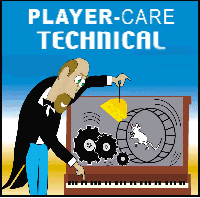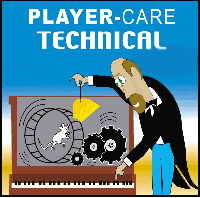
|

|

|

|

|

|
| Home | Manuals | Supplies | Search | Consult | Contact | Testing | Service |


|
Air Motor TimingBelow is my response to a posting in the Mechanical Music Digest which asked about setting the timing of an air motor. Most men (and some women) understand why a spark plug is fired prior to top-dead-center (TDC). However, in an air motor the vacuum must be applied to each bellows shortly after the camshaft lobe for each bellows passes TDC. The further past TDC that the vacuum is applied, the lower the torque will be. If the vacuum is applied before TDC, the air motor will have a noticable jerky nature. The easiest way to insure that the vacuum is applied shortly after TDC is to apply a medium level of vacuum (15") to the motor and then hold the camshaft with your hand, preventing it from turning. Then, allow the camshaft to turn very slowly and watch each bellows as its associated slider valve moves over its associated vacuum port. As the cam lobe for each bellows passes TDC you can see the bellows cloth react to the applied vacuum. Then adjust the slider (up or down) so that the bellows 'pulls' the camshaft 'forward'. Then, allow the camshaft to move 180 degrees and check to make sure that the atmosphere is allowed to enter the bellows before the next bellows starts 'pulling' the camshaft 'forward' Another thing to bear in mind is that if you get the 'start' point of each bellows too close to TDC, the felt bearings in the connecting rod will wear out much faster. I realize that the term 'shortly' is not very precise. Frankly, I've never attempted to measure the actual number of degrees past TDC that produces optimum performance. I imagine there is such a number, but I've never seen it in print in any reference material. Most technical literature relates the optimum position of the slider to the physical location of the vacuum supply port, which varies from manufacturer to manufacturer. With a little bit of trial and error, you'll find the optimum timing. I do know that a well timed (and well rebuilt) air motor will operate smoothly with the main vacuum hose moved away from the supply flange as much as 3/4", if the supply vacuum is about 20". Musically, John A. Tuttle
Sometimes it can be a pain to get the Tempo Indicator correctly adjusted to the position of the sliding tempo valve. Usually, there are four adjustments. 1. Where the pointer mounts on the tempo rod. 2. Where the tempo rods is secured to the upper lever arm. 3. Where the horizontal tempo rod connects to the lower lever arm. (Sometimes this is solid metal, or a bent rod. So it cannot be adjusted.) 4. An inline adjustable link between the lower lever arm and the Tempo Actuating Lever -Or Tempo Control Rod. Also, the rod going into the Tempo Control Box is almost always threaded, which allows you to make fine adjustments without changing any of the main linkage. The main thing to remember is the all of the levers and arms should be positioned such that at their middle position of rotation (or the middle of their arc), the Tempo should be at 70. If such is not the case, the Tempo will be less linear than designed by the manufacturer. FYI, when you start changing the adjustments, start from the sliding valve and work towards the Tempo Indicator, not the other way around. Make sure the Tempo Lever (in front of the keys) is position straight up, and that the other lever at the rear of the rod is pointing straight down. (Sometimes the position of the rear lever is adjustable.) Also, understand that the function of the air motor governor (AMG) also comes into play during the entire adjustment process. So, getting the governor to work correctly at 70 is a prerequisite to adjusting the "0", "10", and "70" tempos. This is because the functions of the AMG and the Tempo Control are interactive. So, using a test roll (or a roll that has a mark at every foot) should be played at different pedal pressures to insure that it stays at '70' whether you pedal softly or loudly. The importance of this cannot be over emphasized. BTW, normally there is no bend in the rod that connects to the tempo slide valve. Or, if there is one, it is very near to the sliding valve, i.e. within the last inch of the rod just above the sliding valve.
|

![]() ..To
The Top of this Page . . . . . . . . . . .
..To
The Top of this Page . . . . . . . . . . . ![]() ..To The HOME Page
..To The HOME Page
|
Since "Player-Care" is an internet business, I prefer that we correspond via E-Mail (click here to fill out the 'Request Form'). However, if I'm not in the middle of some other activity, you can reach me at 732-840-8787. But please understand that during the hours from 8AM-5PM EST (Mon-Sat), I'm generally quite busy. So, I probably won't answer the phone. If you get the answering machine, please leave a detailed message stating the reason for your call. Also, repeat your name and phone number clearly and distinctly. By necessity, I prioritize everything in my life. And, if you call and just leave your name and number, and ask me to call you back, it might be a day or two before I return your call. Why? Because I don't know why you want me to call and I might not be prepared to assist you in an effective and efficient manner. If you leave me an E-Mail address (which I prefer), spell it out phonetically. The more you do to help me, the more I can help you in return. Don't rush. You have four minutes to record your message. |
|
407 19th Ave, Brick, NJ, 08724 Phone Number 732-840-8787 (Voicemail Only, No Texts) |
